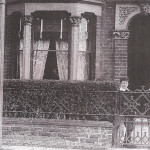
This kind of school had come into being at the time compulsory education began. Local authorities started to set up special schools “for those children whose education is neglected by their parents, or who are found wandering or in bad company”.
This was a boarding school for boys from all over the area. Its 85 pupils had all encountered problems of some sort, either at their former schools or at home. Not all of them were truants – that is, had habitually stayed away from school. Some came from families where the authorities felt they would come to harm – for example if a parent had been convicted of crime. Others had been on the fringes of crime themselves. Yet others were homeless, and were found begging on the streets.
The official aim was to give the boys a second chance in life, to provide them with a decent education and the opportunity to learn a trade so they would be able to earn their living. Sometimes the boys were found proper apprenticeships. As time went on, the authorities began to provide vocational training to pupils. This was evidently of variable quality, and in some instances the practical lessons included activities such as wood chopping and cleaning, which arouses the suspicion that the pupils were being used as cheap labour.
It was not a school that expected to have many famous old boys. An exception to this was Job Driver from Barking, who, like many former pupils, went into the regular army. Job joined in 1912 at the age of seventeen. So it was that he was part of the British Expeditionary Force that went to Belgium and France in the first days of the First World War in 1914. During a retreat from a much bigger German force, Job was one of those who volunteered to try to retrieve a set of horse-drawn guns under heavy fire. He and his colleague succeeded in bringing one of the guns back, and they and their captain were all awarded the Victoria Cross for their bravery.
Job Drain immediately became something of a local hero. The headline in an item about him in “The Walthamstow and Leyton Guardian” was headlined “”How Walthamstow Truant Boy Won VC”, made much of his past, but agreed he had shown “his worth and his manliness”. Job Drain was to survive the war, having risen to the rank of sergeant. He returned to live in Barking, where he worked in a variety of jobs including as a fish porter and bus driver; he married and had two children, finally dying in 1975, and is commemorated with a statue in Barking.
Few of the thousands of other boys who attended the Truant School are now remembered. It remained open as an approved school until the Second World War, even though there were concerns about the quality both of the accommodation and of the education. One of the local MPs, Reg Sorenson, was concerned in 1936 about the facilities and whether there was proper heating. After the school moved to Hertfordshire, Northcotts was used as the headquarters of the Heavy Rescue Service, which dealt with the effects of bombing. After the war it was used by the council for storage. Sadly, it was demolished in 1965.










